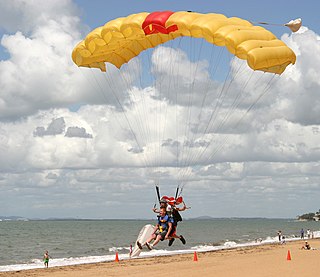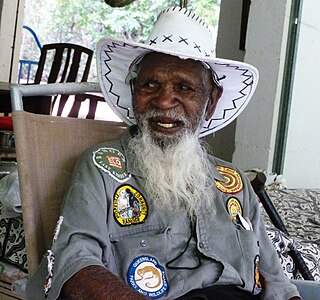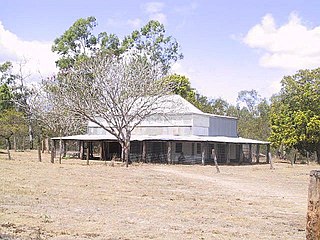The Cape York Telegraph Line was a telegraph line built on the Cape York Peninsula, Queensland, Australia. It was completed in 1887 and stretched from Laura to Thursday Island.
The Cape York Telegraph Line was a telegraph line built on the Cape York Peninsula, Queensland, Australia. It was completed in 1887 and stretched from Laura to Thursday Island.
One of the more important events in the history of the Cape York Peninsula region was the construction of the Overland Telegraph Line. The northern section ran through very difficult country and the telegraph survey expedition was only the fourth overland expedition ever made to Cape York Peninsula. [1]
The construction of the line was to be a major undertaking, commencing with the initial surveying expedition in 1883, led by John Bradfield, [2] which was to take more than two years to complete. The actual construction work involved the clearing of a corridor approximately two chains wide, or around forty metres, with specially manufactured galvanised iron poles used to support the line. Once the telegraph line was completed, ongoing maintenance was important, with gangs of telegraph linesmen dedicated to its upkeep. [1]
Work on the Cape York Peninsula section was completed in 1886, except for 90 km between Moreton Telegraph Station and Mein where telegrams were carried by horse and rider until the line was completed. The line consisted of galvanised cast iron poles designed to support a single wire.
Frank Jardine, after whom Australia's most northerly river is named, was given the job [3] of arranging delivery of materials to work gangs along the line. During the wet summer season of 1886-87, only 35 km of line were built and 200 km of clearing completed to the last station at Mein.
The line opened in 1887 and it linked Brisbane as the capital with Queensland’s northern outposts as well as the rest of the world. This was a vital communication link, stretching from Laura at the southern end of the Peninsula to Thursday Island.
A number of telegraph stations were constructed along the length of the line including:
After more than 100 years of service, the line was closed in 1987, being replaced by microwave transmission. [4] Tenders were called initially for removal of the wire, and later for removal of the poles and cross arms but it was too late! Insulators, wires and even poles have been removed, many for use in stockyards, gates and sheds, and remain a testimony to the durability of the galvanised poles, which were reused without further coating, even though they were by this time 110 years old.

Rinyirru (Lakefield) is a national park in Lakefield, Shire of Cook, Queensland, Australia, 1,707 km northwest of Brisbane and 340 km north-west of Cairns by road, on Cape York Peninsula. At 5,370 km2 - making it bigger than Trinidad and Tobago and almost as big as Brunei - Rinyirru is the second largest park in Queensland and a popular place for fishing and camping.

Cape York Peninsula is a peninsula located in Far North Queensland, Australia. It is the largest wilderness in northern Australia. The land is mostly flat and about half of the area is used for grazing cattle. The relatively undisturbed eucalyptus-wooded savannahs, tropical rainforests and other types of habitat are now recognised and preserved for their global environmental significance. Although much of the peninsula remains pristine, with a diverse repertoire of endemic flora and fauna, some of its wildlife may be threatened by industry and overgrazing as well as introduced species and weeds.

Redcliffe is a town and suburb in the City of Moreton Bay, Queensland, Australia. It also refers colloquially to the Redcliffe Peninsula as a whole, a peninsula jutting into Moreton Bay which contains several other suburbs. Since the 1880s, Redcliffe has been a popular seaside resort in South East Queensland. In the 2016 census, the suburb of Redcliffe had a population of 10,373 people.

Coen is a rural town and coastal locality in the Shire of Cook, Queensland, Australia. The town of Coen is inland on the Peninsula Developmental Road, the main road on the Cape York Peninsula in far northern Queensland. In the 2021 census, the locality of Coen had a population of 320.

The Russian–American Telegraph, also known as the Western Union Telegraph Expedition and the Collins Overland Telegraph, was an attempt by the Western Union Telegraph Company from 1865 to 1867 to lay a telegraph line from San Francisco, California, to Moscow, Russia.

The Australian Overland Telegraph Line was an electrical telegraph system for sending messages the 3200 kilometres between Darwin, in what is now the Northern Territory of Australia, and Adelaide, the capital of South Australia. Completed in 1872, it allowed fast communication between Australia and the rest of the world. When it was linked to the Java-to-Darwin submarine telegraph cable several months later, the communication time with Europe dropped from months to hours; Australia was no longer so isolated from the rest of the world. The line was one of the great engineering feats of 19th-century Australia and probably the most significant milestone in the history of telegraphy in Australia.

Tommy George Sr. was an elder of the Kuku Thaypan clan on Cape York Peninsula, Queensland, Australia. He was the last fluent Awu Laya speaker.

Australia was a relatively early adopter of electrical telegraph technology in the middle of the nineteenth century, despite its low population densities and the difficult conditions sometimes encountered in laying lines. From 1858 onwards, the major capitals were progressively linked, culminating in the addition of Perth in 1877. Australia was linked to the rest of the world for the first time in 1872, through the Overland Telegraph which ran some 3,200 kilometres (2,000 mi) from Adelaide through to Darwin. The network continued to expand in size and sophistication until 1959 and in heavy usage until 1945, after which time telephone usage began to erode public patronage of telegraphy services. The final publicly provided telegraphy service was closed in 1993.

The Redcliffe Peninsula line is a 12 km (7.5 mi) stretch of heavy gauge dual-track railway between Petrie and Kippa-Ring on the Redcliffe peninsula in Queensland, Australia. The new line is part of Queensland Rail's City suburban network, branching from the North Coast line. It starts 200 metres (656 ft) north of Petrie railway station, extending from.

The Bamaga and Telegraph Roads link the Peninsula Developmental Road (PDR), at a junction 117 km (73 mi) north of Coen, with Airport Road in Bamaga, Queensland to the North. The southern part of the road, between PDR junction and Bramwell Junction, is named Telegraph Road. The northern part of the road between Bramwell Junction and Bamaga is named Bamaga Road. The Bamaga and Telegraph Roads are also referred to as the Northern Peninsula Road.

Oppenheimer poles are galvanised iron telegraph poles. They consist of three oval sections that collapse into each other telescope-style for transportation. Once extended, the joints between the sections are clamped with collars. The pole is fixed to a base for support with a u-bolt.

Lytton Hill is a heritage-listed signal station via South Street, Lytton, City of Brisbane, Queensland, Australia. It was built from 1859 to c. 1945. It is also known as Lytton Redoubt, Reformatory, and Signal Hill. It was added to the Queensland Heritage Register on 25 August 2000.

Coen Carrier Station is a heritage-listed telegraph station at Coleman Close, Coen, Shire of Cook, Queensland, Australia. It was designed and built in 1942 by the Postmaster-General's Department. It is also known as Coen Telegraph Station and Coen Carrier Repeater Station. It was added to the Queensland Heritage Register on 27 May 1997.

Old Laura Homestead is a heritage-listed homestead in Rinyirru National Park, Lakefield, Shire of Cook, Queensland, Australia. It was built from 1902 onwards. It was added to the Queensland Heritage Register on 28 July 2000.

Musgrave Telegraph Station is a heritage-listed former telegraph station and now roadhouse at Peninsula Developmental Road, Musgrave, Yarraden, Shire of Cook, Queensland, Australia. It is also known as Musgrave Roadhouse. It was added to the Queensland Heritage Register on 21 August 1992.
The Kaantyu people are an Aboriginal Australian people of the Cape York Peninsula in north Queensland. They live in the area around the present-day town of Coen. Most of their traditional tribal land has been taken over for cattle stations. Kaantju refers to the hook of the yuli, their word for woomera.
The Paterson Telegraph Station was a telegraph station in Queensland, Australia. It was the original location for the end of the Cape York Telegraph Line. It was the landing point for the undersea cable Telegraph Cable between Cape York Peninsula and Thursday Island.
The Olkolo or Koko-olkola' are an Indigenous Australian people of central and eastern Cape York Peninsula in northern Queensland. According to Norman Tindale, they are to be distinguished from the Kokangol, higher up on the Alice River watershed.
The Lotiga, also known as the Okara, were an indigenous Australian people of the Cape York Peninsula of North Queensland.
![]() This Wikipedia article was partially based on "Queensland Places – Musgrave Telegraph Station" written by Brian Randall and published on 21 May 2015 by the John Oxley Library under CC-BY 4.0 AU [ permanent dead link ] licence (accessed on 16 February 2017).
This Wikipedia article was partially based on "Queensland Places – Musgrave Telegraph Station" written by Brian Randall and published on 21 May 2015 by the John Oxley Library under CC-BY 4.0 AU [ permanent dead link ] licence (accessed on 16 February 2017).